Easy Sourdough Starter with Yeast
Love sourdough bread but don’t want to wait 1 -2 weeks for your starter. Try this Easy Sourdough Starter with yeast to get an almost sourdough bread in a lot less time!
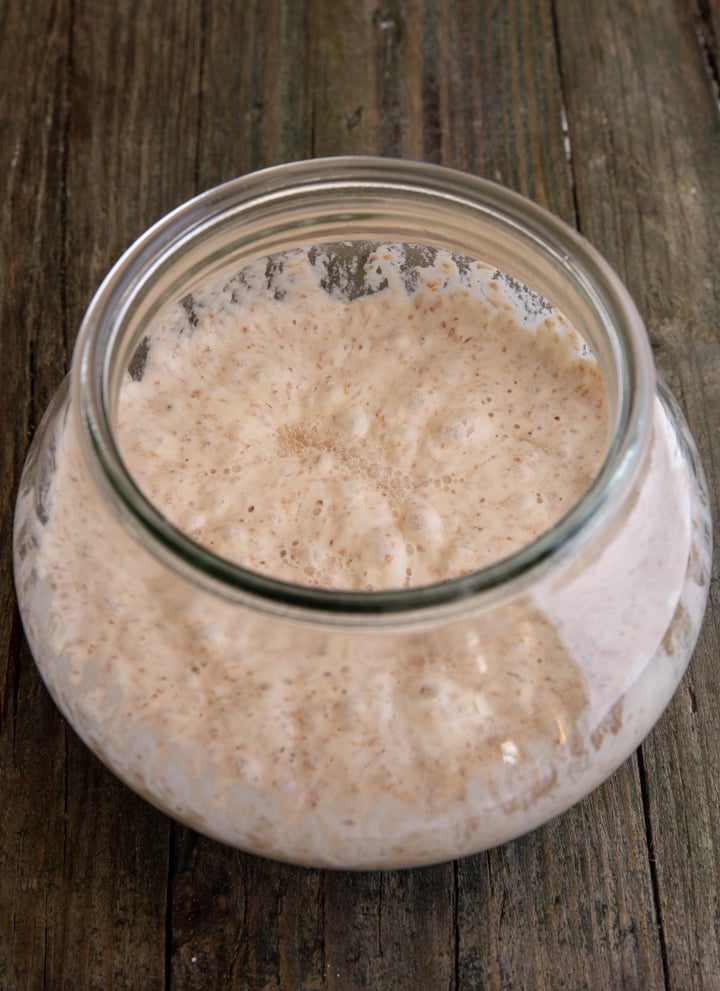
I found this gem of a recipe in my Mom’s recipe folder, I don’t ever remember her making it, but I thought it looked interesting and might be worth sharing. And yes it was. This type of starter is also known as Cheater Sourdough Starter. My husband loves the bread I make with this starter cheater / pretend? Whatever it works and it works well.
Table of Contents
How to make it
In a medium bowl add the lukewarm water and sprinkle the yeast on top. Let it sit for about 5-10 minutes then stir.
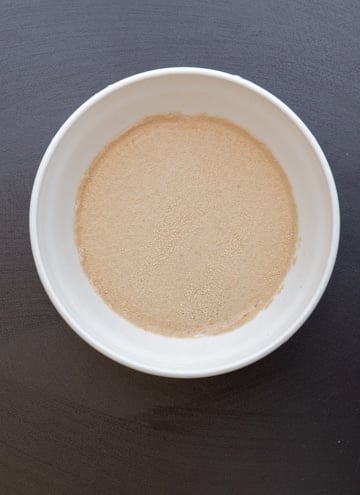
Add the flour to the yeast and combine well, make sure there is no flour at the bottom of the bowl.

Move to a clean bowl or jar, cover with a towel, plastic wrap or place the lid on the jar without sealing and let sit for 24 hours in a warm draft free area.
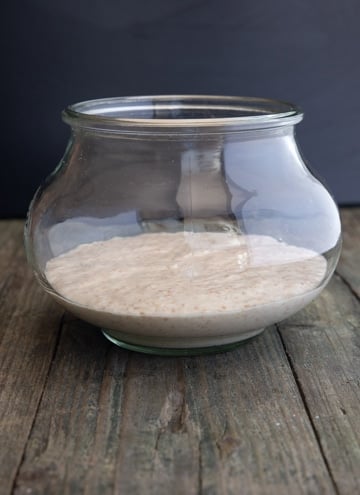
After the 24 hours it should have risen and become very bubbly with a slight sour smell. And it is now ready to use for baking.
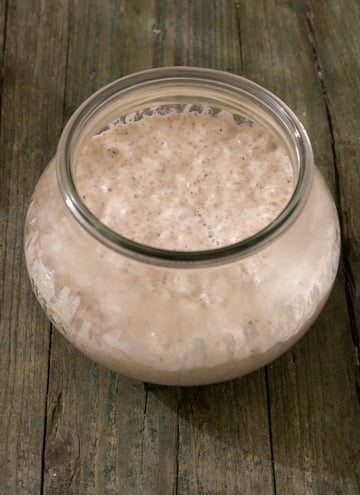
How to use it
Once the starter has sat for 24 hours and it is nice and bubbly it is ready to be used. If you don’t want to bake anything or you have leftovers, then just refrigerate it. Just like you would a regular Sourdough Starter. This type of sourdough starter can last for years, just be sure to feed it weekly if not using.
When you decide to bake with it, just remove it from the fridge let it sit at room temperature for about 2 hours, then remove 1/2 cup of starter and feed with 1/2 cup of lukewarm water and 1 cup of flour, mix together until well combined. Cover with plastic wrap or the lid (just place it on top do not close).
Let sit in a warm draft free area for approximately 3-4 hours or until doubled. Whatever you don’t use for the recipe place in a clean jar and refrigerate until you are ready to use it again. If the starter hasn’t doubled then just repeat the feeding until it does double in size.
The remaining starter that is not fed is called discard, this can be used to make in many recipes including Focaccia and Cookies. Or it can also be used to start another starter. Great for giving to friends and family.
The discard can be used immediately or stored in the fridge for up to 5-6 days.
If there is a liquid on top (called Hooch) of the starter when you remove it from the fridge just stir it in and continue with the feeding, this is normal since it has been sitting in the fridge.
How to know when the starter goes bad
The starter should have a fruity, yeasty, vinegary or even overripe fruit smell but if it starts to smell like something is rotting then it is time to throw it out and start new.
How to store it
Just like regular sourdough starter it can either be kept in the fridge and fed weekly, I have actually let it go a few weeks without feeding and it’s fine. Or leave it on the counter and feed and use daily.
What flour to use
For this recipe I used a mixture of whole wheat and all purpose, you could use just all purpose or bread flour, or a mixture of rye. Whole grains are considered best to add because they contain more nutrients and microorganisms than all-purpose flour which is better for growing your sourdough starter.
What water to use?
Be sure to use lukewarm water between 98-105F (36-40C). And be sure to use water without chlorine, that can kill your starter dough starter. And of course not distilled water. Regular filtered tap water is fine.
So if you are looking for a quicker “sour dough” starter why not give this Sour Dough Starter with Yeast a try and let me know how it goes. Tomorrow I will share a delicious bread I made with this starter. Enjoy!
Easy Sourdough Bread with Starter with Yeast
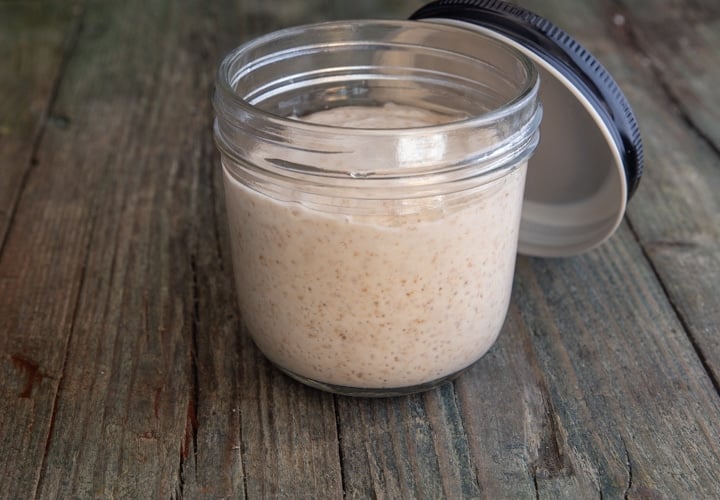
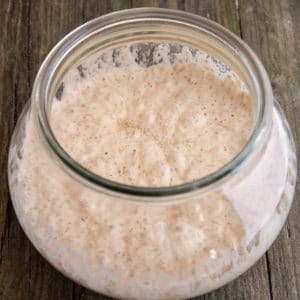
Easy Sourdough Starter with Yeast
Ingredients
- ¾ cup all purpose flour or bread flour (97.5 grams)
- ¼ cup whole wheat flour (32.5 grams)
- ½ cup +3 tablespoons water (lukewarm) (166 grams)
- ½ teaspoon active dry yeast
Instructions
- In a medium bowl add the lukewarm water and sprinkle the yeast on top. Let it sit for about 5-10 minutes then stir.
- Add the flour to the yeast and combine well, make sure there is no flour at the bottom of the bowl.
- Move the starter to a clean bowl, cover with a towel, plastic wrap or place the lid on the jar without sealing it and let sit for 24 hours in a warm draft free area. Do not stir.
- After the 24 hours it should have risen and become very bubbly with a slight sour smell. And it is now ready to use for baking.

I had put it in a pint jar and 3 hours later it was leaking out of the container. So, I had to move it to a larger jar. Will it still be okay?
Hi Lisa, yes it should be fine. 🙂
“A recent study performed by the Wolfe lab in the Department of Biology at Tufts University, which uses fermented foods to study microbiomes, showed that the dominant yeast species in most sourdough cultures is Saccharomyces cerevisiae—the very same species used in store-bought yeast.”
I’ve done both the natural and the “cheater” starter methods over the years and can assure any doubters that using yeast will result in a delicious sour taste, time after time. Though you get bubbly results quicker by using yeast, the intense sour flavor will still require time and feeding, the same as the natural wild yeast starter method.
So use the cheater method and get started baking! Over the course of a month your baked goods will taste better and better!
Hi Toni, thanks so much, that’s so interesting and helpful. Take care and have a wonderful Sunday.
Hi Rosemary, thanks for this recipe. I have caught wild yeasts in the past, but wanted to do a quicker method this time. All yeasts started off wild. The genome came from somewhere. Lol as it ages, I know it will gain more of the sourness some are looking for. I want something that is changing the carbs in my flour, like the lactobacillus I have changes the lactose in my milk for my yogurt.
I am doing a more fermented foods lifestyle for health reasons. ❤️??
Hi Kit, I really don’t know much about changing the carbs in flour, I do have a regular sour dough starter https://allthingsbread.com/sourdough-starter/. For lowering carbs in flour you may want to use a seed or nut flour.
I think this is a good way to tempt bakers to try ‘sourdough’ baking.
Surely, in my humble opinion, yeast is yeast and will attract airborne yeasts from around it as it’s standing.
I do have ‘proper’ sourdough starter in my fridge and has been in and out of the fridge being fed and used for about 2 years now. By what I read in Rosemary’s recipe, it seems that the starter that she makes with the quick start yeast goes on to be fed, used and stored in the fridge until needed later on after its initial 24 hour rest and rise on the bench. I’m no expert but it seems it will attract airborne yeasts regardless. It may take a little time before it gets the sour smell of sourdough but still worth a go.
Waiting to see if your starter will live or die when started from scratch (which is what I did) can be a bit of a ‘nail-biting’ time, but with the above recipe everyone is pretty sure of success.
Thanks Rosemary for making it possible for new bakers to try Sourdough. :))
Hi Mary, thanks so much, you said so much better than I did. Of course there is nothing like classic sourdough starter but this is a good alternative. Have a great weekend.
Is this interchangeable with sourdough starter in any recipe?
Hi Teresa, yes I think you could use it in any sourdough recipe. Take care.
This is a poolish, not a sourdough starter. It won’t taste anything like a sourdough.
Hi Jennifer, actually leftover is kept in the fridge and refed just like a classic sourdough as I mentioned in the post. 🙂
How long is this good for?
Hi Michael, for as long as you keep it active, I have kept mine in the fridge up to 2 weeks before feeding it again and it’s fine. Some have managed up to a month before feeding. As long as you feed it it will last in the fridge. Hope that helps.
SOUNDS GOOD BUT AT WHAT TEMPERTURE DO YOU BAKE IT AT AND FOR HOW LONG?
Hi Leo, I just posted a recipe today to make bread with the recipe. https://allthingsbread.com/easy-sourdough-bread/.
It will work, but it defeats the purpose of creating natural yeast. When you add the yeast this way it will overpower any other yeast and will not have the same flavor that a natural started yeast will provide.
Hi Steven, yes I know that, I have a natural yeast on the blog also, it’s just an easier and faster way to make homemade bread for some people. 🙂